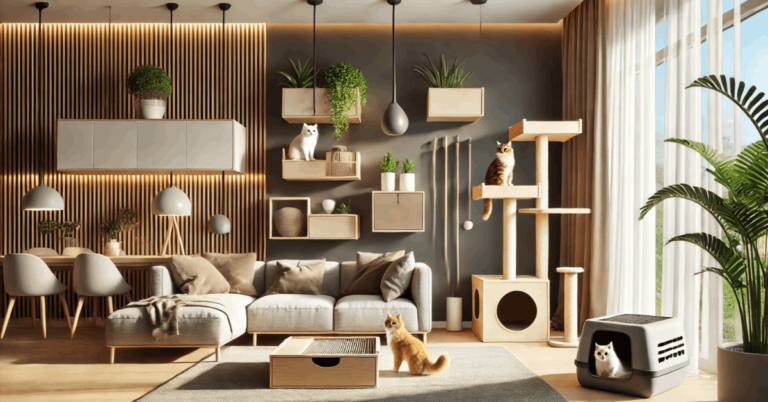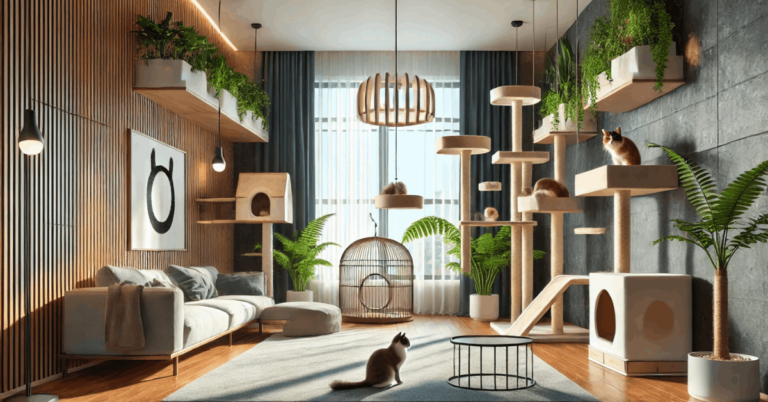Cats are naturally curious and active. Protecting a home and ensuring a safe environment for cats is essential for minimizing potential damage or harm caused by their behavior.
Cats often jump, chew, pounce, and scratch, driven by their instincts to explore their surroundings.
Items in the living area that attract their attention must be secured to prevent accidents or damage.
Cat-proofing ensures a safer space for both cats and the household, benefiting cat owners.
Cat-Proofing Your Living Area for a Safer Home
Living rooms can be full of hidden hazards for cats, including electrical cords, blinds, open windows, and heavy furniture.
Cat-proofing is essential to ensure their safety while also protecting your furniture and belongings from curious claws and teeth.
Here’s a guide to making your living space cat-friendly.
Sofas and Couches:
- Cover sofas with plastic covers temporarily to deter scratching.
- Keep a water spray bottle handy to redirect unwanted scratching behavior.
- Place a scratching post or cat play area near the couch to provide an acceptable outlet for scratching or energy release.
Drapery and Blinds:
- Replace looped cords on window treatments with safer alternatives or cut the loops.
- Tie up cloth drapes out of your cat’s reach until they become accustomed to using a scratching post.
- Secure blind cords with rubber bands, or consider switching to cat-resistant blinds.
Windows and Screens:
- Lock window screens to prevent your cat from falling out or getting stuck.
- Test window screens to ensure they don’t easily pop out under pressure. Replace them if needed.
- Install cat-proof screens or use safety nets when opening windows.
- Lower blinds to discourage window climbing.
Breakable Items:
- Move fragile vases and knickknacks out of your cat’s reach or store them in cabinets.
- Avoid placing items near the edge of shelves to prevent them from falling.
Electrical Cords:
- Unplug unused cords and cover or hide them behind furniture or under rugs.
- Use cord protectors for exposed cables.
- Apply lemon or lavender-scented sprays to cords to discourage chewing.
- Provide safe chewing alternatives to redirect attention.
Doors:
- Secure swinging doors to prevent accidental head injuries.
- Keep all doors leading outside adequately shut and locked.
- Replace door handles with knobs or modify handles to prevent your cat from opening doors.
- Teach your cat to wait for you before moving through doorways.
Furniture:
- Place cat trees or scratching posts next to bookshelves to redirect climbing instincts.
- Secure top-heavy furniture to the wall to prevent tipping.
- Push bookshelves flush against walls to eliminate hiding spots.
- Always check reclining furniture before use to ensure your cat’s safety.
Cat-Proofing Your Bedroom
Keeping your bedroom comfortable while managing a cat’s presence requires minor adjustments to protect furniture and create boundaries.
Here are specific steps to maintain a clean, cat-friendly bedroom:
Mattress and Pillows:
- Use a mattress protector to shield against cat hair, dust, and germs.
- Add pillow protectors to prevent hair buildup and extend the life of your pillows.
Bed Protection:
- Opt for a bed with a metal or wooden frame to discourage scratching.
- Place a cat scratcher near the bed to redirect clawing behavior.
- Set up a cozy cat bed in the room to give your cat a designated spot away from your bed.
Cat-Proofing Your Kitchen
Cats often explore kitchen counters and cabinets, making this area a potential hazard. Use these steps to keep your cat safe:
- Secure Cabinets: Keep all cabinets, cupboards, and pantry doors closed. Install child-proof locks to prevent curious paws from opening them.
- Store Hazardous Items Safely: Place cleaning supplies, medicine, and plastic wrap on high shelves and behind closed doors. These items can be harmful to cats if accessed.
- Avoid Dangerous Foods: Keep toxic foods like alcohol, coffee, chocolate, grapes, and raisins stored securely. Even small amounts of these can be poisonous to cats.
Cat-Proofing the Bathroom
Bathrooms should be off-limits for cats whenever possible. If access is necessary, ensure the space is as safe as possible.
Dental Floss
Dental floss poses a risk to cats, so store it in a closed cabinet. Ensure the trash can has a secure lid to prevent any access.
Items like string, rubber bands, hair ties, and yarn can also cause harm. These objects can strangle or lead to digestive issues if ingested.
Toilet Seat
Always keep the toilet lid down to prevent your cat from falling in or drinking from it.
Store toilet bowl cleaners and other chemicals in a closed cabinet, out of your cat’s reach. Avoid using automatic toilet cleaners as they can be harmful.
Cat-Proofing the Laundry Room
The laundry room can pose serious risks to cats if not adequately secured. Follow these tips to ensure it’s a safe space for your feline friend:
Dryers and Washing Machines:
- Always check inside the washer and dryer before starting a cycle. Cats are drawn to warm, enclosed spaces.
- Keep the washer and dryer doors shut when not in use to prevent your cat from climbing in.
- Store fabric softener sheets and laundry pods in sealed containers or locked cupboards. These items can be toxic if ingested.
Cat-Proofing a Balcony
Install a net or secure cat pen to ensure your balcony is safe for cats. This prevents them from chasing birds or squirrels and risking a fall.
For balconies with plants, remove or replace any toxic ones to protect your cat from accidental poisoning.
Safe House Plants for Cats
Keep houseplants in inaccessible areas or rooms where cats are not allowed. Safe options include African violets, bamboo, and feather palm.
Always confirm plant safety with a veterinarian before introducing new plants to your home.
Plants That Are Toxic to Cats
Certain plants can cause serious cat health problems, including vomiting, kidney failure, or worse. Toxic plants include:
- Aloe vera
- Amaryllis
- Azaleas
- Castor bean
- Chrysanthemums
- Cyclamen
- Daffodils
- Lilies (the most dangerous, often leading to kidney failure)
- Pothos
- Sago palms
- Tulips
- Yew
Cat-Proofing Your Yard or Garden
To make an outdoor space safe for cats, focus on eliminating hazards and creating a secure environment. This ensures your cat can explore safely without exposure to toxins or dangers.
Hazardous Chemicals:
- Store antifreeze, motor oil, and windshield fluid in locked cabinets or areas out of reach.
- Clean up antifreeze spills immediately—it’s highly toxic to cats.
- Avoid using ant and roach poisons. Opt for animal-safe repellents instead.
- Refrain from using rodent bait, snail poison, paint, herbicides, fertilizers, and insecticides. These can harm cats if ingested or touched.
- Skip traditional rodent traps, which pose risks to cats.
Safe Trash Management:
- Use covered garbage, recycling, and compost bins to prevent cats from scavenging.
- Plastic trash cans are safer than metal ones since they don’t have sharp edges.
Conclusion
Creating a safe and cat-friendly home involves thoughtful adjustments across all areas of the house.
You create a safer and more harmonious environment by securing potential hazards, providing designated spaces for your cat’s natural behaviors, and removing toxic substances or items.
These efforts protect your cat and reduce stress for everyone in the household, ensuring a happier coexistence.


